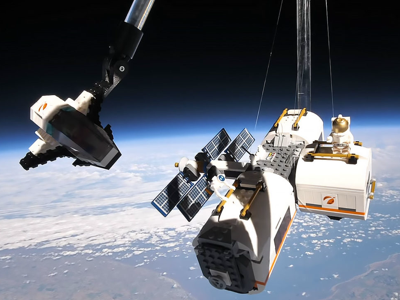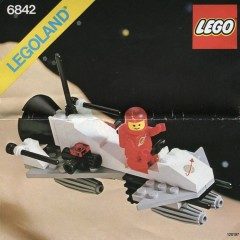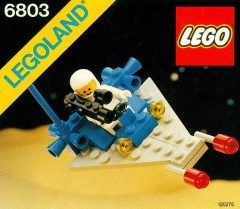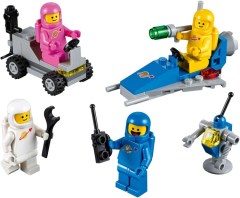Pine Rivers Family Fun Fair 2021
LEGO in Space
1964-2021
Thanks for visiting! Here’s a digital archive of my LEGO In Space display.
What’s on the page? It starts with an overview of all the sets that were on display.
Then there’s a video of the “greatest hits” that we couldn’t fit in.
Some trivia follows about LEGO actually IN space.
What? You’re still there? OK. How about a ‘short’ (ahem) history of LEGO in Space?
These are some of the sets on display.
Sets like 1975’s “Space Module”, the original flagship “Galaxy Explorer 497”, and Blacktron’s “Super Nova II” are some of my Frankenstein monsters … I don’t own the originals, so have been assembling them from parts found over the years.
Video
Where's the Rest?
I’m not made of money! There are hundreds and hundreds of sets, and my pockets are only so deep!
Also, we’d need a LOT more tables to fit them all.
Why not watch this video (that was looping behind the display) to see some of the ‘greatest hits’ that didn’t make it ….
actually
Yeah, Yeah, But has LEGO Actually Gone to Space?

First Minifig In Space(*?)
Andreas Mogensen, the first (human) Danish astronaut, arrived at the International Space Station (ISS) in 2015 with Lego bricks and minifigs. Because … um … why not? LEGO is a Danish invention, so why not play well in space?

First Minifig In Space(*?)
In 2012 a pair of 17 year-olds launched a minifig literally into the stratosphere when their high-altitude balloon project soared 24km straight up.
Their video shows what LEGO goes up, must come (tumbling) down.

MiniFigs in
Jupiter Orbit
Jupiter, his wife Juno and Galileo Galilei gazed upon Jupiter in 2016 when NASA’s Juno spacecraft arrived.
*Technically they are the first minifigs in space as they were launched on the ship in 2011.

Are They Still There?
Apparently there were over 20 minifigs and a good amount of bricks taken to the ISS by Andreas Mogensen.
Are they still there?
Is it lonely in space, or are they being looked after?

LEGO Space in Space
Sent into Space, a company in the UK that does crazy things, celebrated 40 years of LEGO’s Space theme by … well … sending a LEGO set into space!
Much like their ground-blazing Canadian friends, the set floated aloft on a high-altitude balloon.

More? You want MORE?
Good. Go and immerse yourself in the magnificent celebration of LEGO’s Space themes, lovingly put together by Diego Baca:
history
A brief history of
LEGO in Space!

This 276 piece set, an interpretation of the Apollo program, was designed by the legendary Jens Nygaard Knudsen … the man who would go on to create the classic Space theme.

This 276 piece set, an interpretation of the Apollo program, was designed by the legendary Jens Nygaard Knudsen … the man who would go on to create the classic Space theme.
LEGO’s first space ‘set’ was a simple rocket, with no instructions, released in 1964.
It wasn’t until 1973 that LEGO released a set with instructions: the 276 piece Rocket Base, an interpretation of the Apollo program designed by the legendary Jens Nygaard Knudsen … the man who would go on to create the classic Space theme.
This was followed in 1975 by the Lunar Lander (also by Knudsen), which featured a lunar rover and three astronauts – all built out of bricks. Minifigures wouldn’t debut for another three years.
The now famous “Classic” Space range debuted in 1978, a year after Star Wars but developed many years before.
Models in the opening wave include the Mobile Rocket Launcher, Space Cruiser, and two bases: Alpha-1 and Space Command. Special lunar base plates were then made available individually, followed by a slew of ships: from the 39 piece Space Shuttle through to the pride of the fleet: the Galaxy Explorer.
What started with a red and white astronaut minifigure grew into a squadron of yellow, blue and black.
Classic Space featured explorers (no ‘good guys’ or ‘bad guys’), and used grey, white, blue, yellow and black bricks, with translucent yellow for windows and translucent red or green highlights.
The original series was also known for its printed computer designs, down arrow print, and the now iconic space logo – first seen on the minifigs, then printed on slopes, wedges and bricks.
The first monorail appeared in 1980’s Beta I Command Base, which ferried astronauts across two base plates (around 60 studs) from the command room to the shuttle launch pad.
Three years after launch, white bricks started appearing in ship design, and 1983 saw the yellow spaceman added.
1984 saw design aesthetics shift with the addition of new plates allowing for different wing designs, plus the debut of the black minifig.
Each years wave would feature new bricks, colours, or gimmicks. 1985 welcomed new translucent panel green, robot assistants, and bendable yellow pipes, while Light and Sound was added in 1986 into a limited range, including the Sonic Robot and XT Starship. Future sub-themes would continue to feature Light and Sound, including the SP-Striker (a prisoner transport ship), Blacktron 2’s Alpha Centauri Outpost, 1994’s Unitron Monorail Base, all the way through to 1998’s Insectoids range.
The “Classic” Space theme ran into 1987, finishing with the symmetrical, blinding-white Polaris I Space Lab, when it handed the baton to Futuron, which saw new spacesuit design (including rounded sections), and paved the way for “good guy versus bad guy” sets.
Futuron launched with one of the holy grails of LEGO Space collectables: the 6990 Monorail Transport System (Monorail! Monorail! – nah, it’s more of a Shelbyville idea). Far larger in footprint than you would imagine, this was the first design that set fans hearts aflutter, with its battery motor allowing for transportation across the one metre track in both directions.
1987 also welcomed Blacktron, the criminals of the galaxy who would be the foils for Space Police released a year later. This was the goth period for LEGO Space, with epic ships made entirely of black pieces, highlighted in yellow. A special factor in some designs, such as the Renegade, was its asymmetrical layout, with a launchable ship on the right cantilever giving a truly unique look.
Blacktron also took the modular concept originally tested in Classic Space’s detachable designs and raised them to new levels. The Renegade could seperate into six different components which could mix and match to create multiple vehicles.
The Space Police stood alongside Futuron in 1989 with bold designs of translucent orange against black and blue – almost mocking the evil Blacktrons – thus the triumvirate of Good – Police – Evil was formed. The idea of three seperate themes running concurrently would continue on and off until 1997.
Magnets were utilised in the M-Tron sets of 1990, easily recognisable by their red and neon green canopies – plus the large M logo.
Blacktron II (or the Future Generation) updated their logo, which of course required Space Police to add a II to their title.
The amusingly named Ice Planet 2002 debuted in 1993. The “2002” apparently refers to the designation of the ice planet Krysto, but to the rest of us appears to be an interesting prediction of what’s coming in a mere 9 years time. Ice Planet saw a blue / white colour scheme return, replacing the black dominance of the previous five years.
Unitron and Spyrius battled it out in 1994, with new ship designs that taok a sharp turn away from the previous ideas seen in Space: reminiscent of the classic round shape of traditional UFOs. Spyrius’s red / black / translucent blue palette was in stark contrast to Unitron’s clean white and trans blue, wedged ships. If you’re going to spy, you probably should be difficult to see.
Although some see 1995’s Aquazone as an underwater Earth theme, it was actually designed as an alien world exploration theme. Even though it had sharks, octopus and other Earth animals.
1995 saw space return to earth with LEGO Town (the precursor of City) release the Launch Command range of realistic items based on NASA’s space shuttle.
The Exploriens of 1996 took many of the previous best bits and merged them into a fun new world with magnets, sharp angles juxtaposed against rounded panels, and an updated logo with a throwback to the classic logos ship. Was it a surveillance vehicle, a laser canon, an exploratory vehicle – or all of the above? Names of vehicles in this range included Decoder, Alien Fossilizer, Detector, which could be appropriate for exploration or military.
Running side by side in 1997 were UFO, a range of vehicles piloted by alien robots, and Roboforce, an entire range of vehicles and machines shaped like robots driven by spacemen. Fortunately the UFO range did feature a number of ships with the iconic saucer shape, including the 369 piece, heavily sticker 6975 Alien Avenger.
The left-field ideas of the previous year were told to hold the beer of Insectoids in 1998: an entire range of bizarre shaped ships all in the form of an insect, piloted by just as odd alien minifigs. The parts in this range were outstanding, allowing creative builders to experiment with different shapes and techniques.
1999’s Rock Raiders is only considered by a handful to be a sub-theme of Space as it’s clearly set on Earth, but has references to being off-planet in related games and books.
Again LEGO Town filled the void with their Space Port theme in 1999, with slightly fanciful but mostly realistic ships and vehicles for exploration. From jets to helicopters, all the way up to a 494 piece Mission Control set, this was LEGOs way to keep their toes in both science fiction and science fact.
While some of these sets stayed on shelves until the end of 2000, this appeared to be the first gap in LEGO’s love affair with space, with no sets released during 2000.
Life on Mars in 2001 had a large collection of micro and mini sets, along with larger vehicles, where the theme walked the line between exploration and alien contact. Designs started seeing a mix of the fanciful and practical.
LEGO’s space cobwebs were dusted off with a return to the red planet with 2007’s Mars Mission, which in retrospect almost looks like humanities bad habit of colonising a native species territory. Perhaps the Alien Mothership Assault vehicle wouldn’t have been needed if the Claw-Tank Ambush wasn’t capturing aliens to use as fuel. Just saying.
The orange and white colour scheme, matched with parts normally attributed to city sets (tracks and over-sized wheels) gave this series a unique look.
An interruption to the official Space theme occurred in 2008 with the two Factory (Building YOUR Way) sets: Star Justice and Space Skulls. These are interesting additions to Space, as they were created by Fans as part of the Factory project, where designs could be made and sold under the LEGO brand. A precursor to the IDEAs range, it had less to do with LEGO and isn’t included by most Space overviews. The Skulls set was truly original in design, with the Justice set more a throwback to classic designs.
The Factory road bump and sidetrack to Mars only lasted two years, with a return to the easily comprehendible Space Police 3 series in 2009. An almost militarised police force in stark whites and greys apprehended aliens who looked like extras from the Fifth Element. A magnificent mix of chintzy and fun, this theme also took on the “used universe” concept of Star Wars, Mad Max and Blade Runner to offer an amusing interpretation of the future, one where alien space truckers could hijack a laser from the police and set it up in their rig (5972 Container Heist).
The annual change of themes returned in 2011 with Alien Conquest, with a complete overhaul of how ships of friend and foe were completely redesigned. Aliens returned to the ubiquitous saucer-shape of lore (including a War of the World’s inspired version in the 7051 Tripod Invader), with humans beefing up their vehicles with sturdy military styled defence trucks and jets.
2011 also saw the launch of a slew of LEGO City (don’t say ‘Space’) sets, all with a more realistic, Earth-based approach to space exploration, from the tiny Space Moon Buggy through to a Space Shuttle and Space Centre (including a rendition of NASA’s Titan IV Launch vehicle – branded with an updated Classic Space logo).
After phasing out Alien Conquest, 2013 saw Galaxy Squad bring back insect inspired ships, and simple ‘cop cars’ for policing outer space against alien threats. Larger vehicles in the range really went overboard in their interpretation of alien insect design and defensive weapons – with the stunning and arresting 70702 Warp Stinger and 70703 Star Slicer combo a credible threat against humanities 70704 Vermin Vaporizer (gosh, they really didn’t like the insects, did they?) and the 70705 Bug Obliterator. Ouch. That’s hurtful.
Lego Ideas introduced us to a flash-back to Classic Space with the introduction of a green uniform for the original minifigure in the 2014 Exo Suit design that also featured a dog robot. Two other special sets were released to commemorate the classic range: a retrospective look at the original space minifigure and a book featuring a micro-scale Galaxy Commander.
2014 was the year for homages, with the LEGO Movie debuting Benny’s Spaceship, Spaceship, SPACESHIP in not only the movie, but the toyshops. Like all of the original ships rolled up into one, with the broken-chinstrap adorned Benny at the controls, this monster ship was embraced by LEGO collectors old and young.
The following year the LEGO City range introduced a handful of space sets, which was a precursor to the huge burst of activity in 2019, again with smaller ships through to large complexes like the Deep Space Rocket and Launch Control set.
LEGO has many themes now, having originally only had four launched in 1978, and Space sets can be released under any of these new monikers. The Creator 3-in-1 theme has seen a number of releases from 2017 onward, including Robot Explorer & Space Shuttle Explorer, and Creator Expert’s spectacular Lunar Lander to celebrate humanity landing on the moon 50 years prior in 2019. This year a new Space Shuttle Discovery set was released by Creator Expert.
Thanks to Benny’s love of Classic Space we saw the release of Space Squad in 2019 with new versions of classic ships, and in celebration of the original minifigure series, an orange spaceman joined the ranks in 2020.
And you shouldn’t forget the power of LEGO Ideas – the new fan-driven range where anyone can submit a design to be voted on. The most popular designs make their way to official designers to peruse to identify which ones are worthy of the LEGO badge. So far LEGO Ideas has given us the Hayabusa (JAA – Japanese Aerospace Exploration Agency), Curiosity Rover, Women of NASA, and the gargantuan Saturn V.
Just this year, nine sets have been released that relate to space. The smallest fans can experience Space for the first time with the Duplo Space Shuttle Mission, or the most experienced AFOL can delve into the Creator Expert NASA Space Shuttle Discovery. The child at heart can embrace the retro chic of Mickey & Minnie’s Space Rocket, minifigure collectors have added a new Space Police Guy, while the curious can break out the Creator 3-in-1 futuristic Space Mining Mech suit.
2022 should see the release of three new City sets: Moon Rover, Moon Space Station and Moon Research Base. With these it appears that LEGO is moving back into realistic builds.
But we know anything can happen when a system of interconnecting bricks is concerned.
Who knows what fantastically interesting designs are being thrown around LEGO HQ for space in the future?
Footnote: Why no Star Wars? Because it’s a licensed theme that’s more to do with a heroes journey than space. Same with every other theme LEGO has released, from Batman to the Marvel universe. They adventure IN space. Hmmmm, maybe they should be included? No, no, no, no, no, no … nooooooooooooo. Just getting a ship from every era is going to bankrupt me. Once that’s complete, well …





































